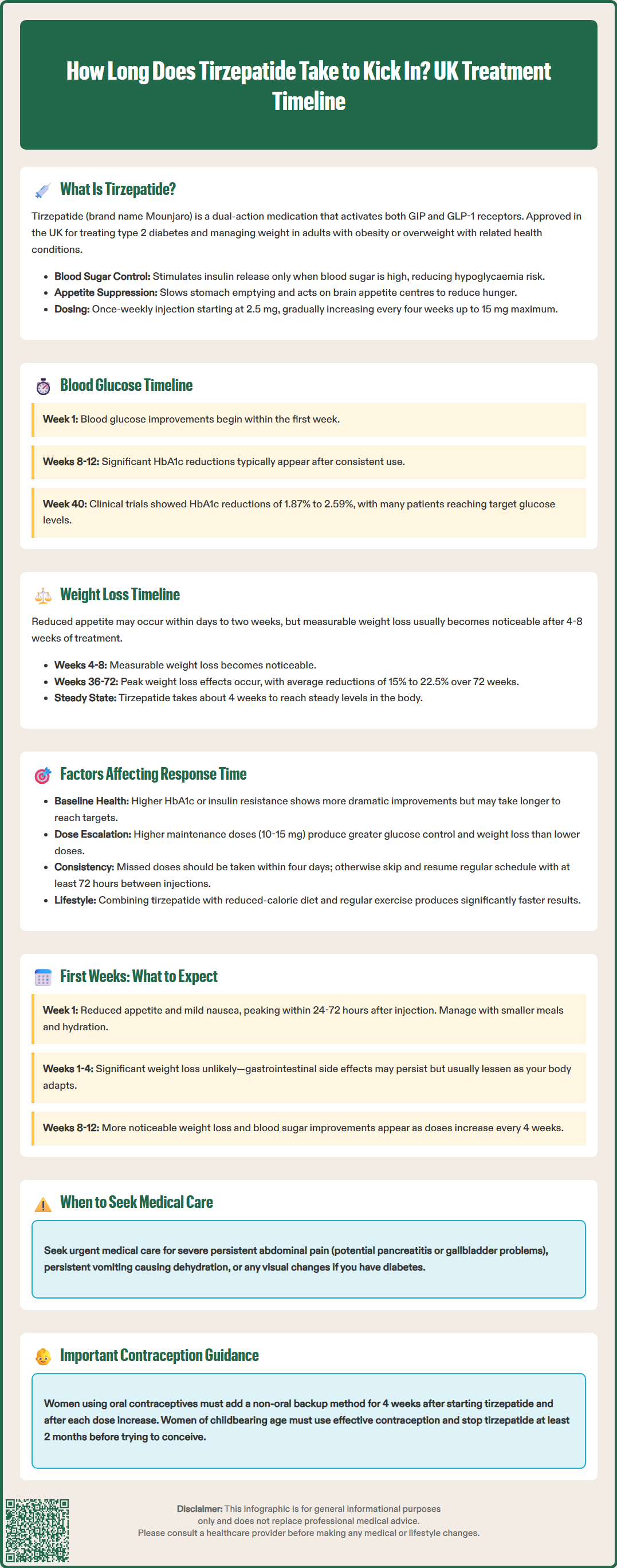LOSE WEIGHT WITH MEDICAL SUPPORT — BUILT FOR MEN
- Your personalised programme is built around medical care, not willpower.
- No generic diets. No guesswork.
- Just science-backed results and expert support.
Find out if you’re eligible

Tirzepatide (Mounjaro) is a dual glucose-dependent insulinotropic polypeptide (GIP) and glucagon-like peptide-1 (GLP-1) receptor agonist licensed in the UK for type 2 diabetes and chronic weight management. Understanding how long tirzepatide takes to work helps set realistic expectations for treatment. Blood glucose improvements often begin within the first week, whilst measurable weight loss typically emerges after 4 to 8 weeks. Peak therapeutic effects develop gradually over many months. This article explains tirzepatide's mechanism of action, expected timelines for different outcomes, and factors influencing individual response to treatment.
Quick Answer: Tirzepatide begins lowering blood glucose within the first week, whilst measurable weight loss typically becomes noticeable after 4 to 8 weeks of treatment.
Tirzepatide is a glucose-dependent insulinotropic polypeptide (GIP) and glucagon-like peptide-1 (GLP-1) receptor agonist licensed in the UK for the treatment of type 2 diabetes mellitus and, more recently, for chronic weight management in adults with obesity or overweight with weight-related comorbidities. Marketed under the brand name Mounjaro in the UK, tirzepatide offers a dual mechanism of action for metabolic health management.
The drug works by mimicking two naturally occurring incretin hormones that play crucial roles in glucose regulation and appetite control. As a GLP-1 receptor agonist, tirzepatide stimulates insulin secretion from pancreatic beta cells in a glucose-dependent manner, meaning it only promotes insulin release when blood glucose levels are elevated. This mechanism significantly reduces the risk of hypoglycaemia compared to some other diabetes medications. Simultaneously, it suppresses glucagon secretion from pancreatic alpha cells, which helps prevent excessive glucose production by the liver.
The GIP receptor agonism component is what distinguishes tirzepatide from single-agonist GLP-1 medications. GIP enhances insulin secretion and may improve insulin sensitivity in peripheral tissues. Additionally, both receptor pathways contribute to delayed gastric emptying, which slows the rate at which food leaves the stomach and enters the small intestine. This effect, combined with actions on appetite centres in the brain, leads to reduced hunger and increased satiety.
Tirzepatide is administered as a once-weekly subcutaneous injection, typically into the abdomen, thigh, or upper arm. The medication is initiated at a low dose (2.5 mg weekly) and gradually titrated upwards every four weeks to minimise gastrointestinal side effects whilst optimising therapeutic benefits. The MHRA-approved maximum dose is 15 mg weekly, though dosing strategies may vary based on individual patient response and tolerability.
It is important to note that tirzepatide is not indicated for the treatment of type 1 diabetes or diabetic ketoacidosis (DKA).
The timeframe for tirzepatide to 'kick in' varies depending on which therapeutic effect is being measured. For blood glucose control in people with type 2 diabetes, improvements in fasting glucose levels can often be observed within the first week of treatment. However, more substantial and clinically meaningful reductions in HbA1c (glycated haemoglobin) typically become apparent after 8 to 12 weeks of consistent use. This delayed effect on HbA1c is expected, as this marker reflects average blood glucose levels over the preceding two to three months.
Clinical trial data from the SURPASS programme demonstrated that patients experienced progressive improvements in glycaemic control throughout the dose-escalation period. By 40 weeks, participants achieved HbA1c reductions ranging from 1.87% to 2.59% depending on the final maintenance dose, with many patients reaching individualised HbA1c targets as recommended by NICE guidelines (often 48 mmol/mol [6.5%] when safe, or 53 mmol/mol [7.0%] if there are concerns about hypoglycaemia risk).
Weight loss effects follow a somewhat different trajectory. Whilst some patients report reduced appetite within the first few days to two weeks of starting tirzepatide, measurable weight reduction typically becomes noticeable after 4 to 8 weeks. Weight loss continues progressively over many months, with peak effects generally observed between 36 and 72 weeks of treatment. In the SURMOUNT clinical trials evaluating tirzepatide for weight management, participants lost an average of 15% to 22.5% of their initial body weight over 72 weeks, depending on the dose used.
It is important to understand that tirzepatide is not an immediate-acting medication. The drug has a half-life of approximately 5 days and reaches steady-state concentrations in the body after about 4 weeks. The physiological adaptations that lead to improved metabolic outcomes develop gradually. Patients should maintain realistic expectations and continue treatment as prescribed, even if dramatic changes are not immediately apparent. Regular monitoring with your GP or diabetes specialist nurse will help track progress and adjust treatment as needed.

Several individual and clinical factors influence how rapidly and effectively tirzepatide produces therapeutic benefits. Baseline metabolic status plays a significant role—patients with higher initial HbA1c levels or greater insulin resistance may experience more pronounced glucose-lowering effects, though they might also require longer to achieve target levels. Conversely, those with milder hyperglycaemia may reach glycaemic goals more quickly but see smaller absolute reductions.
Dosing and titration schedule directly impact treatment response. Tirzepatide follows a structured dose-escalation protocol, starting at 2.5 mg weekly and increasing by 2.5 mg increments every four weeks as tolerated. Patients who can advance to higher maintenance doses (10 mg or 15 mg weekly) generally achieve greater improvements in both glucose control and weight loss compared to those maintained on lower doses. However, some individuals may need to remain at intermediate doses due to gastrointestinal side effects such as nausea, vomiting, or diarrhoea.
Adherence to treatment is crucial. Missing doses or inconsistent injection timing can delay therapeutic effects and reduce overall efficacy. The once-weekly dosing schedule is designed to improve adherence compared to daily medications, but patients must still maintain consistency. If a dose is missed, MHRA guidance recommends administering it as soon as possible within four days; if more than four days have passed, skip the missed dose and resume the regular schedule. Importantly, there must be at least 72 hours (3 days) between injections. The weekly injection day can be changed if necessary, provided there are at least 72 hours between doses.
Lifestyle factors significantly modulate tirzepatide's effectiveness. The medication works synergistically with dietary modifications and increased physical activity. Patients who combine tirzepatide with a reduced-calorie diet and regular exercise typically experience faster and more substantial weight loss than those relying on medication alone. NICE recommends that pharmacological weight management interventions should always be accompanied by behavioural support and lifestyle modification programmes.
Concomitant medications may also influence response. Other diabetes medications, particularly those affecting insulin secretion or sensitivity, can interact with tirzepatide's glucose-lowering effects. Additionally, because tirzepatide delays gastric emptying, it may affect the absorption of oral medications. Notably, tirzepatide can reduce the exposure to oral contraceptives, particularly after initiation and each dose increase. Women using oral contraceptives should use an additional non-oral/barrier method for 4 weeks after starting tirzepatide and for 4 weeks after each dose increase. Patients taking medications with narrow therapeutic windows should discuss timing considerations with their healthcare provider.
Starting tirzepatide requires preparation and realistic expectations about the initial treatment period. During the first week, many patients notice reduced appetite and earlier satiety during meals. Some experience mild gastrointestinal symptoms such as nausea, which is typically most pronounced in the first 24 to 72 hours after each injection. These effects often diminish as your body adjusts to the medication. To minimise discomfort, eat smaller, more frequent meals, avoid high-fat foods, and stay well hydrated.
Weeks 2 to 4 represent the initial adaptation phase. Gastrointestinal side effects may persist but generally become less bothersome. You might begin to notice subtle changes in your eating patterns—feeling satisfied with smaller portions or experiencing fewer cravings for high-calorie foods. If you are monitoring blood glucose at home, you may observe lower fasting readings. However, significant weight loss is unlikely during this early period. It is essential to continue the medication as prescribed even if dramatic changes are not yet apparent.
At week 4, your prescriber will typically increase your dose to 5 mg weekly, provided you have tolerated the initial 2.5 mg dose. This dose escalation may temporarily intensify gastrointestinal symptoms, though usually to a lesser degree than when first starting treatment. The gradual titration schedule is specifically designed to balance efficacy with tolerability. Some patients may need to remain at a lower dose for an additional four weeks if side effects are problematic.
Weeks 8 to 12 mark the period when more noticeable therapeutic effects emerge. Weight loss becomes measurable, and improvements in blood glucose control are typically evident in home monitoring and laboratory tests. Your healthcare provider may check your HbA1c around this time to assess glycaemic response. This is also when dose adjustments continue, with increases to 7.5 mg, 10 mg, or eventually 15 mg weekly based on your individual response and treatment goals.
Important safety considerations during the initial weeks include monitoring for signs of pancreatitis (severe, persistent abdominal pain radiating to the back), gallbladder problems (right upper abdominal pain, especially after meals), or severe gastrointestinal symptoms leading to dehydration. Call NHS 111 or seek urgent care for severe abdominal pain or persistent vomiting/dehydration; call 999 for severe acute illness. Patients with diabetes should report any visual changes and ensure routine diabetic eye screening, as rapid improvement in blood glucose control can sometimes worsen diabetic retinopathy, particularly in those with pre-existing eye disease.
Tirzepatide is not recommended during pregnancy or breastfeeding. Women of childbearing potential should use effective contraception while taking tirzepatide and discuss with their healthcare provider if planning pregnancy, as the medication should be discontinued at least 2 months before a planned pregnancy.
If you experience any suspected side effects, report them to the MHRA Yellow Card scheme (yellowcard.mhra.gov.uk). With appropriate monitoring and support, most patients successfully navigate the initial treatment period and go on to achieve meaningful improvements in metabolic health.
Many patients report reduced appetite and earlier satiety within the first few days to two weeks of starting tirzepatide. These effects result from the medication's action on appetite centres in the brain and delayed gastric emptying.
Clinically meaningful reductions in HbA1c typically become apparent after 8 to 12 weeks of consistent tirzepatide use. This timeframe reflects the fact that HbA1c measures average blood glucose levels over the preceding two to three months.
If you miss a dose, administer it as soon as possible within four days. If more than four days have passed, skip the missed dose and resume your regular schedule, ensuring at least 72 hours between injections.
All medical content on this blog is created based on reputable, evidence-based sources and reviewed regularly for accuracy and relevance. While we strive to keep content up to date with the latest research and clinical guidelines, it is intended for general informational purposes only.
DisclaimerThis content is not a substitute for professional medical advice, diagnosis, or treatment. Always consult a qualified healthcare professional with any medical questions or concerns. Use of the information is at your own risk, and we are not responsible for any consequences resulting from its use.